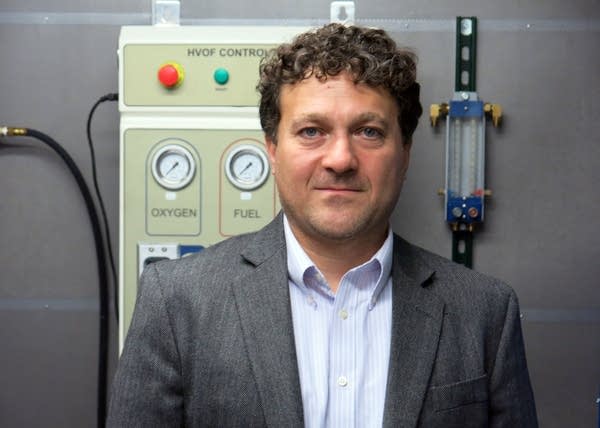Researcher's quest: Oil pipelines that call for help before leaking

Go Deeper.
Create an account or log in to save stories.
Like this?
Thanks for liking this story! We have added it to a list of your favorite stories.
In a small noisy lab, Fardad Azarmi rummages through a few pieces of steel on a table. He picks up a playing card sized chunk covered with a gray coating.
The coating, a mix of metal and ceramic particles sprayed onto the steel at temperatures between 2,000 and 3,000 degrees, is designed to slow the corrosion that can eat away at the insides of an oil pipeline.
Baked into the coating are sensors, each a bit thicker than a human hair, that can identify and track corrosion and also measure stress or cracking.
There's no doubt the coating helps slow corrosion. But Azarmi, a North Dakota State University researcher, has bigger goals. He wants to use the sensors inside the coating to create a wireless monitoring system and maybe even a smartphone app that engineers can use to check on pipelines.
Turn Up Your Support
MPR News helps you turn down the noise and build shared understanding. Turn up your support for this public resource and keep trusted journalism accessible to all.
They've shown in the lab the technology works. Now they're trying to prove it's affordable and commercially viable on critical sections of pipeline.

"We don't think that it is possible to put sensors in the entire pipelines in every inch," Azarmi said. "We have to know usually the problem starts at this point and we have fracture or crack or corrosion at this point. We can put sensors at those areas."
Azarmi and a colleague are in the second phase of a $400,000 study funded by the federal Pipeline and Hazardous Materials Safety Administration. With so much oil traveling across the country now, and so much potential for disaster if it spills, Azarmi says the industry is keenly interested in the technology he developing.
"A good thing about this project is that without advertising or asking anyone, companies and industries are coming to us," he said. Having industry collaborators makes it much more likely his research will someday help improve pipeline safety, he added.
Those who monitor pipeline safety hope for the same, but they caution that technology can't solve everything.
Pipeline technology has improved significantly over the past decade, but the advances have not led to a noticeable decline in pipeline spills, said Carl Weimer, executive director of the nonprofit Pipeline Safety Trust in Bellingham, Wash.

"Especially as new pipelines go in the ground we ought to be seeing the benefits of those things," Weimer said of the new systems.
"It's still a little hard to tell how well it's going to affect older pipelines," he added. "I haven't heard any of them (companies) talking about digging up pipelines and coating them with the latest technology."
Weimar notes that while sensors can produce more data, it's still up to humans to grasp the numbers, and that's still a problem.
Case in point. A 2010 Enbridge spill into the Kalamazoo river in Michigan. Data showed a potential problem before the accident.

"They had all kinds of data but it turned out the right hand and the left hand weren't communicating very well and that was a human thing," Weimer noted. "The people looking at corrosion weren't looking at cracking and didn't realize there was one on top of the other."
Weimer says that's an example of a company not taking full advantage of technology, or choosing to ignore a problem that might cut into profits. Enbridge changed its operations after the Michigan spill. Weimer says pipeline companies often don't embrace safety improvements until after a major accident.
"They all say safety is first but I think they all also recognize that it's not always the truth," he said. "They've started putting systems in place, safety management systems and safety cultures that really try to build the industry to where no one feels threatened if they push the button to close a pipeline down because they have concerns about safety."


